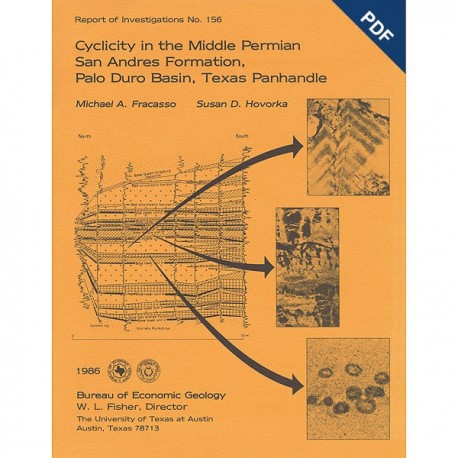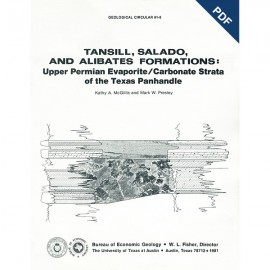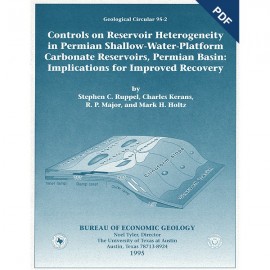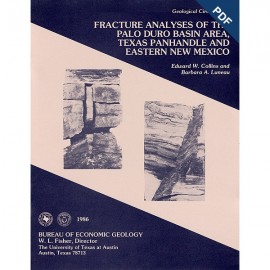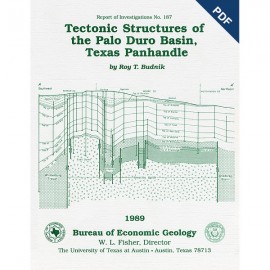Reports of Investigations
-
Books & Reports
- Reports of Investigations
- Guidebooks
- Udden Series
- Geological Circulars
- Down To Earth
- Atlases of Major Oil and Gas Reservoirs
- Texas Memorial Museum Publications
- Environmental Geologic Atlas of the Texas Coastal Zone
- Mineral Resource Circulars
- Other Reports
- Seminars and Workshops
- Handbooks
- Submerged Lands of Texas
- Symposia
- Annual Reports
- Open File Reports
-
Maps & Cross Sections
- Thematic Maps
- Miscellaneous Maps, Charts & Sections
- Geologic Atlas of Texas
- STATEMAP Project Maps
- Geologic Quadrangle Maps
- Cross Sections
- Highway Geology Map
- Energy and Mineral Resource Maps
- Shoreline Change and Other Posters
- Wilcox Group, East Texas, Geological / Hydrological Folios
- Bouguer Gravity Atlas of Texas
- River Basin Regional Studies
- Featured Maps
- Posters
- Teachers & the Public
-
Geological Society Publications
- Gulf Coast Association of Geological Societies
- Alabama Geological Society
- Austin Geological Society
- Corpus Christi Geological Society
- Houston Geological Society
- Lafayette Geological Society
- Mississippi Geological Society
- New Orleans Geological Society
- South Texas Geological Society
- GCS SEPM Publications
- Historic BEG & UT Series
Cyclicity in the Middle Permian San Andres Formation, Palo Duro Basin, Texas Panhandle. Digital Download
RI0156D
For a print version: RI0156.
RI0156D. Cyclicity in the Middle Permian San Andres Formation, Palo Duro Basin, Texas Panhandle, by M. A. Fracasso and S. D. Hovorka. 48 p., 40 figs., 4 pls., 1986. doi.org/10.23867/RI0156D. Downloadable PDF.
To purchase this publication in book format, please order RI0156.
ABSTRACT
The San Andres Formation in the Palo Duro Basin is a middle Permian carbonate-evaporite sequence situated between two red-bed units, the underlying Glorieta and the overlying undifferentiated Queen-Grayburg sequences. The San Andres Formation, deposited during relative structural quiescence in the region, is composed of cyclic sequences of dark anhydritic mudstone, skeletal limestone, dolomite, nodular anhydrite, bedded anhydrite, and halite. These cyclic vertical lithofacies sequences reflect sediment deposition by regressive, upward-increasing salinity cycles in a shallow platform setting. Thin interbeds of red siliciclastic mudstones and siltstones are present throughout the San Andres but become more abundant and thicker near the top of the formation. Textural evidence provided by core shows that the entire suite of cyclic facies reflects predominantly shallow-water deposition. Evidence of subaerial exposure is sparse within carbonate rocks, absent in anhydrite, but intermittently abundant in halite.
Cycles can be traced across the entire Palo Duro Basin study area using geophysical log data. Much thinner sequences, on the order of tens of centimeters thick, also can be recognized using core data and correlated over distances of 118 km between cored wells. The extraordinary regional continuity of thin cyclic units, combined with textural evidence of their subaqueous origin, suggests that sedimentation occurred on an extremely broad, featureless shallow-water shelf characterized by nearly uniform depositional environments over large areas. The great width of the shelf combined with a shallow water depth restricted circulation, which caused development of a lateral salinity gradient soon after the initial, near-normal-marine transgressive phase of each cycle. This salinity gradient is reflected by the lateral equivalence of halite, anhydrite, and carbonate facies along a north-south trend. The dominant source of normal-marine water appears to have been the Midland Basin to the south, although a western normal-marine influence is indicated in some cycles. Vertical and lateral patterns of sedimentation in the San Andres Formation reflect changes in water circulation and resulting brine salinity, which are functions of the dynamic interplay between rates of eustatic sea-level change, regional basin subsidence, and sediment aggradation on a broad, low-slope, low-relief platform.
Systematic vertical changes in the thickness and completeness of cycles allow division of the San Andres Formation in the Palo Duro Basin into three informal genetic sequences. Cycles of the lower San Andres sequence exhibit the complete ideal vertical facies sequence and have a relatively thick carbonate member. Cycles of the middle San Andres sequence contain relatively thin carbonate members and are incomplete because they lack halite members. Cycles of the upper San Andres sequence also have relatively thin carbonate members, but halite is present. The fundamental mode of cyclicity is the same in each of the genetic units, but the cyclic tempo is different. The temporal evolution of cyclic style reflects changes in regional basin subsidence rate or frequency of eustatic sea-level change or both.
Keywords: basin subsidence, core, cyclicity, depositional systems, eustatic sea-level change, evaporites, genetic sequences, geophysical logs, insoluble residue, Palo Duro Basin, Permian, San Andres Formation, sediment aggradation, sedimentary petrography, Texas Panhandle
CONTENTS
ABSTRACT
INTRODUCTION
Geologic Setting
Data and Methods
CYCLICITY IN THE SAN ANDRES FORMATION
Ideal Vertical Cyclic Facies Sequence
Base of Cycle-Dark Mudstone
Carbonate
Anhydrite
Halite
Terrigenous Red Beds
Variation from the Ideal Vertical Cyclic Sequence
Correlation of San Andres Formation Cycles
Styles of Cyclicity in the San Andres Formation
Lower San Andres Genetic Sequence
Middle San Andres Genetic Sequence
Upper San Andres Genetic Sequence
Lateral Facies Relationships, Depositional Systems, and Structural Influence on Sedimentation in the San Andres Formation
Lateral Facies Relationships
Cyclic and Noncyclic Controls on Red-Bed Distribution
Time Lines
Depositional Systems
Structural Influence on Sedimentation
SUMMARY
ACKNOWLEDGMENTS
REFERENCES
Figures
1. Stratigraphic column of Permian rocks in the Palo Duro and Dalhart Basins, Texas Panhandle
2. Permian formations interpreted as transgressive-regressive, carbonate-evaporite and elastic genetic couplets
3. Stratigraphic divisions of the San Andres Formation
4. Location of San Andres Formation cross sections and cored U.S. Department of Energy wells in relation to basement structures, Texas Panhandle
5. Permian shelf-margin progradation, Texas Panhandle
6. Vertical facies sequence and gamma-ray log pattern of an idealized cycle, San Andres Formation, Palo Duro Basin
7. Anhydritic black mudstone, base of unit 5, lower San Andres Formation, Stone and Webster Mansfield No. 1 core
8. Contorted and brecciated texture in insoluble residue from the DOE-Gruy Federal Grabbe No. 1 core
9. Insoluble residue at the base of a middle San Andres cycle, Stone and Webster Detten No. 1 core
10. Depositional environments in lower San Andres unit 4 in cored wells
11. Brachiopod biomicrudite having abundant, large, mostly intact brachiopod shells
12. Syntaxial overgrowth on an echinoderm plate, showing an early generation of cloudy cement with possible relict bladed fabric after aragonite, followed by sparry calcite
13. Ripple-laminated dolomitized carbonate grainstone with carbonate mudstone drapes
14. Micritic ooliths, slightly compressed at the top and strongly compressed at the bottom
15. Laminae in rippled dolomicrite are defined by concentrations of ooids
16. Ooid replaced by halite, anhydrite, and dolomite
17. Dolomitized carbonate mudstone from the Stone and Webster Mansfield No. 1 core
18. Nodular anhydrite in laminated dolomite mosaic
19. Typical nodular anhydrite mosaic from a thin upper San Andres cycle, Stone and Webster Detten No. 1 well
20. Gradation between nodular anhydrite and anhydrite having some nodular texture and some poorly preserved halite pseudomorphs after gypsum
21. Unusual subhedral anhydrite nodules in dolomite matrix
22. Halite pseudomorphs after gypsum in halite, in anhydrite, and in dolomite matrix
23. Tall pseudomorphs after gypsum, now halite with relict growth bands defined by anhydrite, in anhydrite matrix
24. Anhydrite pseudomorphs after gypsum crystals in dolomite matrix
25. Disrupted fabrics at the contact between halite (dark) and anhydrite (light)
26. Model for the origin of the sequence of fabrics observed in the anhydrite parts of cycles
27. Vertically oriented crystals in halite outlined by diagenetic anhydrite
28. Photomicrograph of chevron structure in halite, showing fluid inclusions trapped along relict growth surfaces of bottom-nucleated halite crystals
29. Karst pit in light-colored halite with preserved brine-pool fabrics, filled with coarser halite
30. Karst pit in banded halite filled with a first generation of coarse halite, then with mudstone, finally with displacive halite
31. Chaotic mudstone-halite from top of the San Andres Formation, Stone and Webster Harman No. 1 well
32. Very fine sandstone containing small-scale scours, clay rip-up clasts, clay drapes, and ripple crossbedding
33. Typical mudstone bed within lower San Andres unit 5, showing disruption of fabric by displacive growth and subsequent removal of halite crystals
34. Soft-sediment microfaults in ripple-laminated, very fine grained sandstone with clay drapes and sand-sized clay rip-up clasts.
35. Lower San Andres unit 5, a generally northwest-southeast cross section through cored U.S. Department of Energy wells
36. Relationship between the halite at the top of San Andres unit 4 and the basal cycle of unit 5
37. Anhydrite at the top of the lowest incomplete cycle in unit 5, overlain by dark mudstone
38. Facies variation in the third cycle of unit 5, showing a similar pattern of salinity fluctuation in all the cores
39. Northwest-southeast cross section of middle San Andres cycles in cored U.S. Department of Energy wells
40. Northwest-southeast cross section of the lower three upper San Andres cycles in cored U.S. Department of Energy wells
Plates (in pocket of book)
1. North-south, roughly dip-oriented correlation section A-A', San Andres Formation, Texas Panhandle
2. North-south, roughly dip-oriented correlation section B-B', San Andres Formation, Texas Panhandle
3. East-west, roughly strike-oriented correlation section C-C', San Andres Formation, Texas Panhandle
4. East-west, roughly strike-oriented correlation section D-D', San Andres Formation, Texas Panhandle and eastern New Mexico
Citation
Fracasso, M. A., and Hovorka, S. D., 1986, Cyclicity in the Middle Permian San Andres Formation, Palo Duro Basin, Texas Panhandle: The University of Texas at Austin, Bureau of Economic Geology, Report of Investigations No. 156, 48 p.
